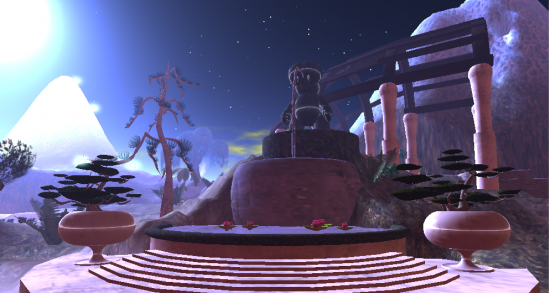The largest grid on the hypergrid will upgrade to the new version of OpenSim on Sunday, October 17. The new version supports media-on-a-prim as well as a more secure hypergrid teleport standard.
The new version is OpenSim version 0.7. OSGrid is currently running version 0.6.9.
The new 0.7 version of OpenSim will allow residents to use the same media-on-a-prim feature that Second Life rolled out this past spring, OSGrid administrator Dave Coyle told Hypergrid Business.
Residents will need to use Second Life Viewer 2 to use the feature, however, until third-party viewers roll out their support for it.
In addition, the grid will be compatible with Hypergrid 1.5, a more secure version of the protocol that allows free and easy teleportation between grids. Previously it was theoretically possible for rogue grid owners to hack into the inventories of visiting avatars. With the new release, this security hole has been closed.

“And whenever mesh support makes it to OpenSim, we’ll be ready for that, too,” Coyle added.
Currently, many other grids have already upgraded to HG 1.5, including German Grid, Dorena’s World, AnSky, ItiMotu, and the University of Edinburgh’s Openvue, grid.
This has caused problems for people wanting to teleport between different grids, since the two versions of the hypergrid protocol are not compatible with one another. People could only teleport from HG 1.0 grids to other HG 1.0 grids, and from HG 1.5 grids to other HG 1.5 grids.
As a result, many other grids, have been waiting for OSGrid to upgrade before they follow suit to avoid being cut off from the largest single population of OpenSim residents in the metaverse.

“Upgrading too early to 0.7 would disconnect the 0.6.9 hypergrid regions,” said Kai Ludwig, owner and manager of the Wilder Westen and Open Neuland grids and CEO of OpenSim hosting company TalentRaspel virtual worlds Ltd. Wilder Westen is currently running HG 1.0, and the majority of all visitors arrive via hypergrid teleport instead of creating accounts on the grid and logging in directly.
“One should wait for the OSGrid 0.7 rollout before upgrading a production grid, because OSGrid has a large base of testers and regions that will for sure find stability bugs within the first two weeks after OSGrid update. So we will wait and move two weeks after OSGrid does.”
At that point, Ludwig said, Open Neuland — which is not currently hypergrid-enabled — will be on the hypergrid as well, though some areas will be closed to foreign visitors.
“Some Open Neuland regions will be blocked from hypergrid access, as the owners only want visitors that have registered themselves,” he said.

OSGrid is the single largest public OpenSim grid — larger than all the other grids combined. As a result, it offers the largest possible test bed for new versions and features, but also puts the most demands on the software, as well.
OSGrid currently has just over 6,100 regions, making it a fifth the size of Second Life by land area.
OSGrid also has the most users of any OpenSim grid, with over 50,000 registered users and more than 5,600 active users last month. This is tiny compared to Second Life, which had 981,865 unique logins during the last 30 days.
OSGrid is the major testing ground for OpenSim, and the grid administrators and volunteers have been testing and debugging 0.7 to get it ready for large-scale deployment.
No rush to deploy
One grid that isn’t about to jump on the 0.7 bandwagon, however, is ReactionGrid, an education and business-focused world that tends to fall on the conservative side when upgrading software. At least, not until the new release has been throughly road-tested and completely debugged.

“We really don’t have plans for this available for public consumption yet,” said ReactionGrid CEO Kyle Gomboy. “When we do, we will announce it though.”
ReactionGrid only upgraded to the previous version of OpenSim, 0.6.9, which was also a significant advance over the previous iteration, this past summer.
“We don’t intend on moving further at this stage until things are nice and stable,” said ReactionGrid CTO Chris Hart. “There are significant requirements in running 0.7 in terms of administration interfaces, and several core database schema changes that make moving forward a lot more work than ever before.”

According to Hart, it can make months of testing to thoroughly debug and then roll out a new version of OpenSim to ReactionGrid’s main grid and to customers’ private grids.
OSGrid normally rolls out new features ahead of ReactionGrid since OSGrid was founded as a testing ground for OpenSim, and ReactionGrid is primarily focused on providing a stable and reliable platform for its education, non-profit and business customers.
Other OpenSim hosting providers have been offering their clients an option to upgrade early — and will also allow their customers to wait and upgrade later.
At Dreamland Metaverse, for example, customers have been able to opt for the OpenSim 0.7 release since two months ago, said company founder Snoopy Pfeffer, and some have already been using it.
Dreamland Metaverse offers regions on any of the open grids, including OSGrid, as well as on private grids and mini-grids.
“I will migrate all OSGrid regions of my customers at the same time OSGrid migrates,” Pfeffer told Hypergrid Business. All the regions on a single grid have to upgrade at the same time, to maintain their grid connectivity.
“The users of standalone regions [or mini-grids] can decide when they want to do this move,” Pfeffer added. “Some, especially bigger corporations, will wait a bit longer to not risk any instability that might be caused by the new OpenSim version.”
- International singers gather on Alternate Metaverse Grid for first annual International Day - April 15, 2024
- OpenSim hits new land, user highs - April 15, 2024
- Wolf Territories rolls out speech-to-text to help the hearing impaired - April 15, 2024
